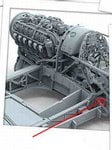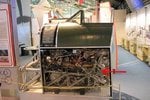Airframes
Benevolens Magister
The harness Fraser is wearing is the Irving seat-type parachute harness, with 'turn and press' quick release box. The seat harness is the latter Sutton harness, with the round, lever-action, quick release box, but without the 'grommet' holes, as shown in the cockpit photos and the pic of the harness I posted.
I think Eduard do a late Sutton, as do HGW, in their micro-fabric range.
I'll see what I can find showing where the hydraulic hand pump handle attaches, but to be honest, the attachment area will be very low down, and out of view on the model.
EDIT: I had a look at one of the cutaway drawings I have, and the scale plans, but they aren't very clear in showing the attachment point, especially when enlarged. However, this pic of the forthcoming Airfix 1/24th scale kit shows the lever, although again the actual attachment to the pump operating crank can't be seen, so I've marked the approximate area with the red arrow.
I think Eduard do a late Sutton, as do HGW, in their micro-fabric range.
I'll see what I can find showing where the hydraulic hand pump handle attaches, but to be honest, the attachment area will be very low down, and out of view on the model.
EDIT: I had a look at one of the cutaway drawings I have, and the scale plans, but they aren't very clear in showing the attachment point, especially when enlarged. However, this pic of the forthcoming Airfix 1/24th scale kit shows the lever, although again the actual attachment to the pump operating crank can't be seen, so I've marked the approximate area with the red arrow.
Attachments
Last edited:


